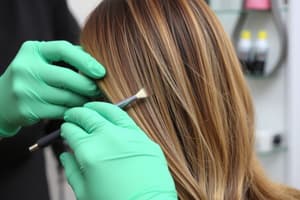Podcast
Questions and Answers
What are abductors?
What are abductors?
- Muscles that draw the fingers together
- Muscles involved in breathing
- Muscles that separate the fingers (correct)
- Muscles of the foot that move the toes
What muscle moves the toes and helps maintain balance while walking and standing?
What muscle moves the toes and helps maintain balance while walking and standing?
Abductor Hallucis
What is anabolism?
What is anabolism?
Constructive metabolism
What does anatomy study?
What does anatomy study?
What does the angular artery supply?
What does the angular artery supply?
What is the primary function of the autonomic nervous system?
What is the primary function of the autonomic nervous system?
What is the basic unit of all living things?
What is the basic unit of all living things?
What is the cardiac muscle?
What is the cardiac muscle?
What is the function of hemoglobin?
What is the function of hemoglobin?
What do exocrine glands do?
What do exocrine glands do?
Which artery supplies blood to the face, head, and neck?
Which artery supplies blood to the face, head, and neck?
What is the function of the digestive system?
What is the function of the digestive system?
What type of tissue is known as liquid tissue?
What type of tissue is known as liquid tissue?
What is the primary function of the lungs?
What is the primary function of the lungs?
What is the hyoid bone?
What is the hyoid bone?
What is the largest bone in the arm?
What is the largest bone in the arm?
What is the name of the seven bones located in the neck region?
What is the name of the seven bones located in the neck region?
Flashcards are hidden until you start studying
Study Notes
Muscles and Anatomy
- Abductors: Muscles that separate fingers for movement and dexterity.
- Adductors: Muscles at the base of fingers that bring them together, contributing to grip strength.
- Bicep: Key muscle shaping the upper arm, important for elbow flexion and lifting.
- Gastrocnemius: Major calf muscle that facilitates foot movement by pulling down the foot.
- Deltoid: Triangular shoulder muscle allowing for arm abduction and rotation.
Body Systems and Functions
- Anabolism: Constructive metabolism process, important for repairing tissues and building structures.
- Catabolism: Metabolism phase breaking down complex compounds, crucial for energy release.
- Circulatory System: Comprises heart and vessels, responsible for blood circulation and nutrient transport.
- Endocrine System: Collection of glands affecting bodily growth, metabolism, and sexual function via hormonal secretions.
- Integumentary System: Includes skin and accessory organs, protecting the body and regulating temperature.
Nervous System Components
- Central Nervous System: Encompasses the brain and spinal cord, fundamental for reflexes and processing sensory information.
- Auriculotemporal Nerve: Affects the external ear and skin on the temple and scalp.
- Buccal Nerve: Responsible for motor functions of the mouth muscles.
- Greater Occipital Nerve: Influences sensation in the scalp, affecting hair and skin.
- Dendrites: Branch-like structures that receive impulses and transmit them to the nerve cell.
Vascular Structures
- Arteries: Thick, muscular tubes that transport oxygenated blood from the heart to tissues.
- Capillaries: Microscopic vessels facilitating exchange of nutrients, gases, and wastes between blood and tissues.
- Veins: Carry deoxygenated blood back to the heart; external jugular vein drains the head and neck.
- Common Carotid Artery: Supplies blood to the face, neck, and head regions.
- Facial Artery: Primarily responsible for blood supply to the lower face.
Key Bones and Nerves
- Humerus: The largest arm bone, crucial for upper limb movement and stability.
- Femur: Longest bone in the body, extending from knee to hip, fundamental for walking.
- Cervical Vertebrae: Seven spinal bones in the neck region, providing structural support and mobility.
- Hyoid Bone: U-shaped bone at the base of the tongue, supporting tongue function and swallowing.
Respiration and Excretion
- Lungs: Main respiratory organs facilitating oxygen and carbon dioxide exchange.
- Excretory System: Group of organs such as kidneys and liver, crucial for waste removal and detoxification.
- Inhalation/Exhalation: Air intake (inhalation) and carbon dioxide expulsion (exhalation) are vital for respiration.
Additional Important Terms
- Histology: Study of microscopic structures of tissues, essential for understanding complex biological processes.
- Hemoglobin: Protein in red blood cells vital for oxygen transport.
- Liquid Tissue: Includes blood and lymph, responsible for nutrient transportation and waste removal within the body.
- Epithelial Tissue: Protective layer on body surfaces, crucial for barrier functions against pathogens.
- Connective Tissue: Diverse group of tissues that provide support and bind different organs and systems in the body.
Studying That Suits You
Use AI to generate personalized quizzes and flashcards to suit your learning preferences.




